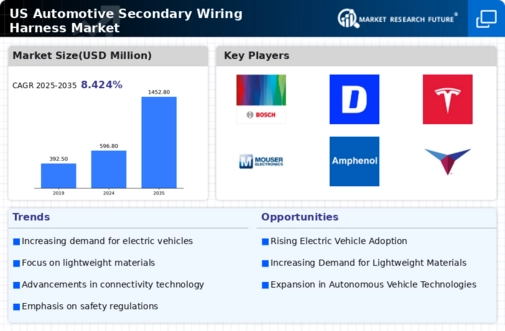The US Automotive Secondary Wiring Harness Market is a critical segment within the broader automotive industry, characterized by its intricate wiring solutions that support various functionalities and systems in vehicles. This market is increasingly competitive due to the rising demand for advanced automotive technologies, such as electric vehicles and enhanced electronic systems. Companies within this market are focused on innovation, quality, and the ability to adapt to the changing landscape of consumer needs and regulatory requirements.
Players are investing in research and development to create lightweight, efficient, and durable wiring harness systems that can accommodate the growing complexity of automotive designs. As vehicle manufacturers seek to optimize performance and enhance user experience, the competitive dynamics are shaped by various factors including technological advancements, strategic partnerships, and the ability to maintain cost-effective production processes.
Bosch has established a strong presence in the US Automotive Secondary Wiring Harness Market by leveraging its extensive expertise in automotive components and systems. The company is recognized for its commitment to quality and innovation, which allows it to deliver high-performance wiring solutions that meet the stringent requirements of modern vehicles. Bosch's strengths lie in its global supply chain management, advanced manufacturing capabilities, and a comprehensive portfolio of products that includes harnesses designed for various vehicle applications.
The company's strategic approach to partnerships with automakers and focus on developing sustainable solutions further enhance its position in the market, allowing it to cater to the evolving demands of the automotive industry. Bosch's continuous investment in technology and infrastructure bolsters its ability to remain competitive amidst a rapidly changing market landscape.
Yazaki Corporation plays a significant role in the US Automotive Secondary Wiring Harness Market, recognized for its engineering prowess and commitment to innovation. The company specializes in designing and manufacturing wiring harnesses tailored for a wide range of automotive applications, including electric and hybrid vehicles. Yazaki's strengths center around its robust research and development initiatives, which drive the creation of cutting-edge products that enhance vehicle performance and safety. The company has established a comprehensive network within the US through various manufacturing facilities and partnerships with major automotive manufacturers.
Additionally, Yazaki has engaged in numerous mergers and acquisitions, enabling it to expand its product offerings and boost its competitive advantage in the market. With a strong emphasis on sustainability and efficiency, Yazaki Corporation is well-positioned to meet the growing demands for advanced wiring solutions in the automotive sector, contributing to its success in the US market.























Leave a Comment